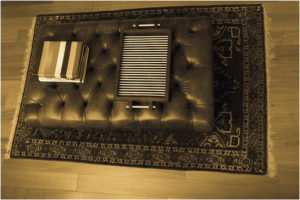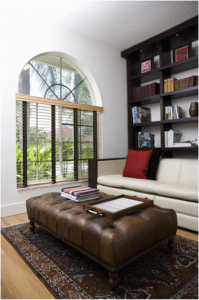 This photo shows a rug, ottoman coffee table and a few accessories in a neutral sepia tone. It gives you the chance to see how texture affects the look of this arrangement.
This photo shows a rug, ottoman coffee table and a few accessories in a neutral sepia tone. It gives you the chance to see how texture affects the look of this arrangement.
Start with the warm wood floors. They provide just the right backdrop to the dramatic Oriental rug. The complex design and tonal shifts add much of this image’s interest. You can tell that this rug is authentic by looking at the fringe. In true Orientals, the fringe on one side is about twice as long as the fringe on the other. That’s because what you perceive as fringe is actually the trimmed ends of the rug weaving.
The smooth leather of the ottoman benefits from buttons that show off its texture and personality. On top a tray and folded throw add additional texture and tonal contrasts.
 Now let’s look at the same arrangement in the context of the room and in color. Any surprises? Notice the unexpected color of the throw pillow? Also, did you expect the rug to be in reds rather than blue and brown?
Now let’s look at the same arrangement in the context of the room and in color. Any surprises? Notice the unexpected color of the throw pillow? Also, did you expect the rug to be in reds rather than blue and brown?
One interesting feature of the ottoman/rug area in context is the change in approach. Most of the rest of the space is black and white with a few splashes of red. However, there is just enough brown to bring everything together.
Color always has a tendency to distract from texture and tone. To get a better sense of both, head to a quilting shop and pick up a red plastic square used to look for tonal matches in fabric. You can do the same thing these two photos did – look at the same vignette in color and with the color removed.
